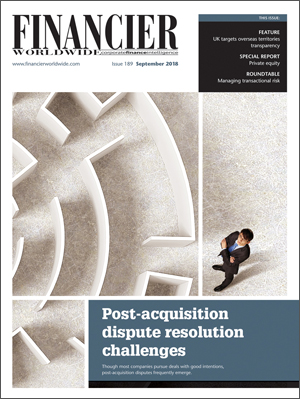Illumination and transparency via the SFTR
September 2018 | FEATURE | BANKING & FINANCE
Financier Worldwide Magazine
As another piece of the European Union’s (EU) regulatory reporting jigsaw, the aim of the Securities Financing Transactions Regulation (SFTR) is to improve the transparency of securities financing markets and shed light on the often murky world of shadow banking.
According to NEX Regulatory Reporting’s ‘SFTR: the key challenges and how to overcome them’, the SFTR casts the regulatory spotlight on a segment of the market that has historically been lightly-regulated and under-reported: repo and securities lending, and the reuse or rehypothecation of collateral.
The NEX report also notes that while the fast-expanding shadow banking sector is recognised as playing a constructive role in providing alternative sources of credit, it is also regarded as opaque, not on the regulators’ radar, and therefore a potential source of financial instability and systemic risk.
Key provisions
Boiled down, the SFTR states that: (i) a recipient of collateral may only reuse it if the provider has been informed of the risks and has given consent; (ii) alternative investment fund (AIF) and undertakings for the collective investment of transferable securities (UCITS) managers must disclose their use of securities financing transactions (SFTs) to their investors; and (iii) both counterparties must report new, modified or terminated SFTs to a trade repository.
In terms of implementation, the SFTR is being phased-in gradually, with the collateral reuse and investor disclosure requirements already in place, and trade repository reporting rules expected to come into effect in Q1 2020. In many ways the transparency requirements of the SFTR have parallels (but also points of difference) with those of other regimes, such as the revised Markets in Financial Instruments Directive (MiFID II) and the European Market Infrastructure Regulation (EMIR).
“As the countdown to live SFTR transaction reporting continues, market participants need to hone their compliance strategies in order to meet the myriad challenges the regulation presents.”
“The SFTR covers a broad range of SFTs,” says Christian Krohn, a consultant at Bovill. “It prohibits recipients of collateral from reusing that collateral unless the provider has been informed of the risks and has given their prior written consent. It also places an obligation on UCITS and AIF managers to disclose information to investors on their use of SFTs. This will require both SFT counterparties to report details of any SFT they have concluded, modified or terminated to a European Securities and Markets Authority (ESMA)-licensed trade repository on a T+1 basis.”
According to John Kernan, senior vice president and head of product management at REGIS-TR, the SFTR will also “equip regulatory bodies with greater levels of data to monitor risk”.
Compliance challenges
As the countdown to live SFTR transaction reporting continues, market participants need to hone their compliance strategies in order to meet the myriad challenges the regulation presents.
“The sheer amount of data required is probably the biggest challenge,” suggests Mr Kernan. “There are up to 153 fields of data depending on the instrument. Firms should be reviewing technical standards, analysing the data they need and locating it. Unlike the EMIR, the SFTR mandates the use of the ISO20022 standard for reporting to trade repositories. Firms will need to develop this standard to consolidate the fragmented data they collect from in-house systems and external suppliers, and report it to trade repositories in ISO20022 by T+1.”
Another issue is that of data quality. “Even with the more prescriptive ISO20022 and all of the lessons learned from EMIR implementation, there will certainly be data quality issues for all market participants,” adds Mr Kernan. “This implies an ongoing exception management overhead to scrutinise and correct data anomalies between firms and their counterparties.”
In some instances, the compliance challenges posed by the SFTR are partially alleviated by the pitfall avoidance strategies highlighted in the EMIR. “That said, differences in product scope, detail and tolerances means the EMIR reporting model cannot be cut and pasted,” warns Mr Krohn. “One of the key implementation challenges remains ensuring the availability, accuracy and standardised reporting of the extensive data required by the SFTR.”
Going live
With the SFTR going live in early 2020, the preparedness of firms is under the spotlight, with managers contemplating the extent to which the regulation will impact their business.
“While the reuse and disclosure requirements already apply, SFT reporting will be phased-in one year after implementing rules are adopted,” says Mr Krohn. “Preparedness varies but collective initiatives have been launched. For example, the European Repo and Collateral Council (ERCC) has conducted a repo reconciliation exercise to identify and address the SFTR reporting fields most likely to cause issues.”
Whether the SFTR ultimately generates greater illumination and transparency of SFTs, as well as softens the often negative press directed at shadow banking activities, remains to be seen. For now, preparation is the focus and compliance is the aim for market participants.
© Financier Worldwide
BY
Fraser Tennant

